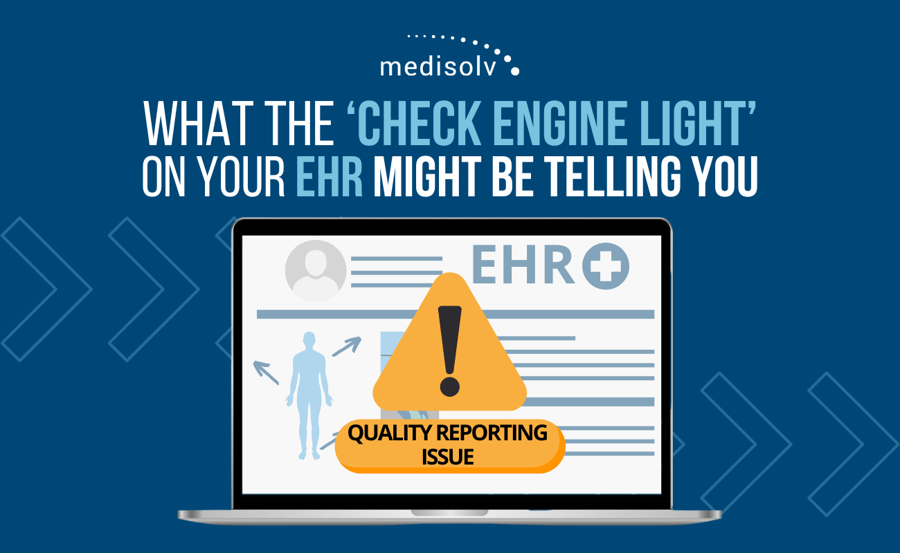What the ‘Check Engine’ Light on Your EHR Might be Telling You

The Hidden Gaps in EHR Quality Reporting (And How to Fix Them)
Electronic Health Records (EHRs) are essential for managing patient data, but when it comes to quality reporting? Let’s just say they might not be built for the long haul. Think of your EHR like a car—it gets you from point A to point B. But when the check engine light comes on, do you ignore it and hope for the best? Or do you take it to a specialist who knows how to diagnose and fix the problem?
Your EHR might be running, but if your quality reporting is throwing off warning signs, it could be time to take a closer look. Here are the gaps many hospitals encounter, and what you can do to keep your reporting in peak condition.
When Your EHR is Flashing the Check Engine Light
1. Missing Data: The Mystery Malfunction
Your EHR is great at capturing patient data, but when it comes to compiling a complete quality report? It’s like trying to diagnose a car issue without a dashboard warning. Missing or inaccurate data leaves reports incomplete—and that’s a serious problem when precision is key.
2. One-Size-Fits-All Issues: The Wrong Parts for the Job
Quality measures are constantly changing, but EHRs aren’t built for that kind of agility. Trying to use your EHR for quality reporting is like putting the wrong-sized tire on your car—it might fit, but the performance will suffer. Expect inefficiencies and constant workarounds.
3. Integration Issues: The Engine and Transmission Aren’t Talking
Quality reporting relies on data from labs, pharmacy, billing, and more—but these systems often operate in silos, even within your EHR. If your reporting tool can’t unify that data, your reports will be incomplete.
It’s like an engine that won’t talk to the transmission—you’re not going far with a system that can’t work together.
4. Lack of Benchmarking: No GPS, Just Guessing
Without benchmarking, you can’t track how your hospital stacks up or where you need to improve. That’s like driving without GPS—you’re moving, but you have no idea where you’re headed.
5. Manual Overload: Doing the Work Yourself
Some hospitals still rely on spreadsheets and manual validation to pull together reports. That’s like pushing your car to work instead of driving it. It’s slow, exhausting, and prone to error.
6. No Submission Support: You’re On Your Own
Most EHRs don’t submit quality data for you—leaving your team to manage formatting, exports, and deadlines. It’s like your car flashing a warning light, then handing you the tools to fix it yourself.
7. Limited Measure Visibility: You Can’t Fix What You Can’t See
Many EHRs only show part of your quality data—making it hard to catch problems or improve performance. It’s like driving with half your dashboard warning lights turned off—you won’t know something’s wrong until it’s too late.
The Fix: How to Get Your Quality Reporting Running Smoothly
If you’re nodding along and thinking, Yep, this sounds familiar, don’t worry—there’s a better way! Instead of struggling with an EHR that wasn’t built for quality reporting, it’s time to upgrade to a solution that’s designed to keep your reporting running smoothly.
1. Get a Purpose-Built Solution
Your EHR is great for care delivery, but when it comes to quality reporting, it’s missing key diagnostics. Medisolv works alongside your EHR to surface what it can’t—ensuring reports are complete, accurate, and ready for submission—no flashing dashboard warnings required.
2. Let Technology Do the Heavy Lifting
Advanced validation tools can catch errors before they turn into penalties. That means less manual work, fewer mistakes, and no more last-minute panic before submission deadlines. It’s like having a dashboard that alerts you before a real issue arises.
3. Bring All Your Data into the Same Garage
Most hospitals rely on a single EHR—but quality data often lives across multiple systems. Medisolv pulls from more than just your EMR, giving you a complete view of performance. No more flying blind with missing pieces under the hood.
4. Know Where You Stand with Real-Time Navigation
Benchmarking tools help you track your progress, set performance goals, and compete confidently. And with expert guidance from Medisolv, it’s like having a navigator who not only shows you where you are—but helps map out the best route forward.
5. Stay Ahead of the Curve with Regular Maintenance
Most EHRs wait until CMS mandates new measures to make them available- leaving you racing to catch up. Medisolv adds measures early, so your team can tune up, test, and improve before requirements kick in. It’s like getting a scheduled service reminder before there’s a breakdown.
Don’t Let Your EHR Leave You Stranded
Medisolv goes beyond compliance—we help you stay in control of your entire reporting journey. Our solutions ensure accurate data acquisition and validation across CMS, The Joint Commission, and other regulatory programs.
With deep expertise across MIPS, MVPs, eCQMs, CQMs, abstracted measures, PRO-PMs, SDOH, and Hybrid measures, Medisolv is like the expert technician and tuned-up engine your reporting process has been missing.
Your EHR might be running—but if it’s flashing warning lights, it’s time for a smarter, more reliable ride.
Schedule a Test Drive to see how Medisolv can keep your reporting on track.
Related: Learn more about Medisolv’s regulatory compliance solutions that support the integration of multiple EHR systems.
Looking to Improve your eCQMs?
|


.png?width=352&name=BlogImage_State%20of%20IQROQR%20Survey%20(4).png)

Comments